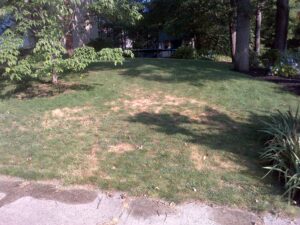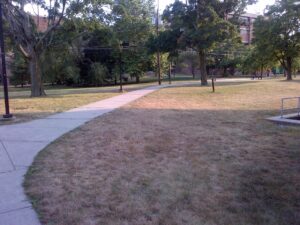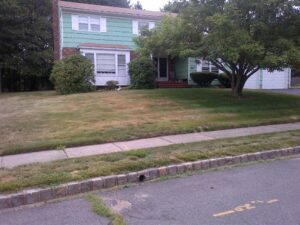Main Content
The question of the day is… How do I know whether the grass that is losing its green color is going dormant or going to die? It isn’t always easy to tell but here are some clues that can help.
First, asses the uniformity of the grass. Is all of the grass turning brown or straw colored? Or… is the grass turning brown in spots or small patches? If the browning is occurring in spots or small patches, there is a good chance the grass plants in those spots are dying, especially if this occurs in a matter of hours to a couple days.

There are many possible reasons for grass dying in spots or small patches. It could be as simple as severe localized soil drying within these spots. The dry spots in the soil develop so rapidly that there isn’t enough time for the physiological changes (dormancy) in the grass to occur. If this is the case, then a thorough watering will be beneficial and stop additional plants from dying. Be advised, it may be difficult to re-wet the soil in these spots because extremely dry soil can become hydrophobic (water repellent).
Brown spots or patchs could also result from an insect or disease that, in combination with drought stress, is killing the grass plants. In this case, watering may not be enough to stop additional injury. The pest problem may also need to be addressed. See the Rutgers Plant Diagnostic Lab if you neeed help identifying a pest problem.

Steady and uniform changes in a turf’s appearance is one indicator that it is developing dormancy (versus dying). Common symptoms of the onset of dormancy include a gradual slowing of shoot (leaf) growth over a period of days, which, if the drying continues, will steadily transition into an even appearance of wilted turf. Eventually, the wilted leaves will dry up and lose green color (chlorophyll) but, again, this should occur evenly and gradually throughout the affected area of turf. These symptoms occuring over a period of hours is not good for survival.
Be aware that some turf loss will probably occur in a turf that goes dormant. Not all the shoots (buds on the crowns of plants) will be able to develop dormancy and survive.
The age of a turf impacts its ability to tolerate stress and survive dormancy. A younger turf has smaller, less developed crowns and root system than older mature turfs. The larger crowns of older turf contain numerous buds (many already dormant) compared to younger plants with smaller crowns and fewer dormant buds. Dormant buds on the crowns of grasses are the part of the plants that resume shoot growth once the drought ends.
Earlier in the growing season, turf growing in the full sun will often dry up and go dormant faster than turf growing in the shade. This difference is due to the cooling effect of the shade as well as a reduced water use rate of the grass growing in the shade.

However, later in the growing season (August and September), you will often notice turf going dormant under trees much sooner than in the full sun. This reflects the microenvironmental difference of lower soil water content under the trees. By August, trees have had sufficient time to delete water from deep in the soil profile under the “drip line”. Summer rains will often keep the soil outside of the “drip line” relatively moist while the soil directly under the tree remains dry (tree canopy adsorbs some of the rain and the tree roots get much of the rain that does reach the ground) and the grass under the tree struggles with drought.